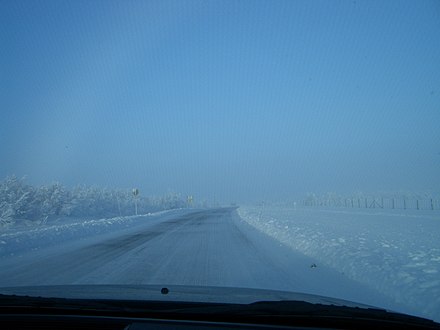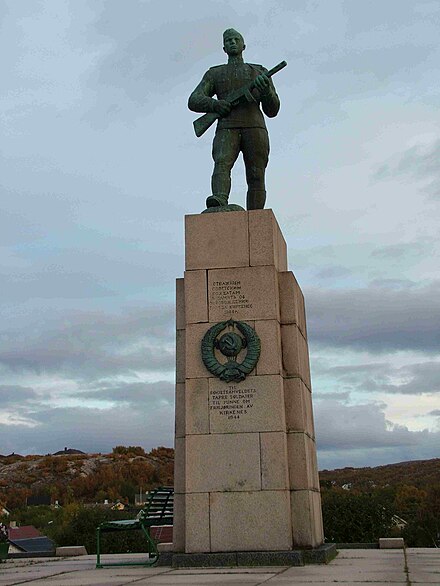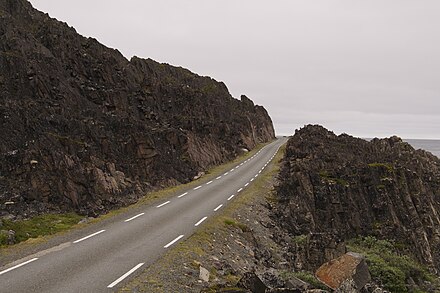Finnmark - former county of Norway (1919–2019)
Finnmark (Sami: Finnmárkku fylka) is Norway's northernmost county, well within the Arctic circle. It is the largest county in Norway by area (48,637 km<sup>2</sup>) but the smallest by inhabitants (74,000 in 2012). Finnmark is the northernmost part of mainland Europe, as well as the easternmost part of Norway.
Towns
- Alta
- Berlevåg
- Båtsfjord
- Hammerfest
- Honningsvåg
- Karasjok
- Kautokeino
- Kirkenes
- Lakselv
- Tana
- Vadsø
- Vardø
- Øksfjord
Other destinations
Understand


Finnmark covers an area about the size of countries like Slovakia, Switzerland or Denmark. From west to east it is almost 1,000 km, comparable to the distance from London to Edinburgh. A large part of the county consists of the Finnmarksvidda plateau at about 300 to 500 metres above sea level. Finnmark's rugged coastline totals about 6800 km if islands are included (more than the coastline of Spain or Chile). The municipality of Kautokeino is about 10,000 square kilometers (4 times the size of Luxembourg) with a population of less than 3,000. Almost 10 % of Kautokeino's area is lake surface. In total there are well over 100,000 lakes in Finnmark.
In Eastern Finnmark the borders of Finland, Norway and Russia coincide, with no less than three different time zones within a few steps. Finnmark is the northernmost of the European continent as well as (east of Kirkenes) the easternmost part of the Nordic countries. Kirkenes sits at about 30°E, corresponding to St. Petersburg or Istanbul.
Nordkapp is promoted as the northernmost point of mainland Europe, which is not exactly true. Nordkapp is on an island, Magerøya, and the neighbouring point Knivskjellodden is actually 1,457 m (4780 ft) further north (on the same island). Nordkapp is however the northernmost point in Europe reachable by the international road network. Islands farther north, such as Novaya Zemlya, are far from the mainland. The northernmost point on the actual mainland (islands like Magerøya not included) is Kinnarodden 60 km to the east, some 25 km wilderness hike from Mehamn village (which is on Hurtigruten and has an airport on the Tromsø–Kirkenes service).
Climate and daylight
Finnmark is Norway's coldest area, but temperatures varies over the county. The interior has a continental climate with winter temperatures down to -40°C/F (record -50°C), while summers can be warm. Karasjok for instance has an annual average at . The coast has chilly summers, and winters that are not so cold but windy (the open sea is ice free in winter). The town of Vardø has an Arctic climate, as even July has a monthly average at 9°C, like most of the outer coastline of Finnmark.
During summer there is a long period of midnight sun (24 hour sun) and vice versa there is a long period in winter during which the sun is below the horizon (polar night, skábma or mørketid, "dark period"). In Alta the polar night lasts from November 25 to January 17.
History

Finnmark was largely destroyed during World War II. The eastern part of Finnmark was on the front between Soviet Union and Germany; fierce fighting took place east of the small town of Kirkenes, which was subjected to more than 300 bombing raids. When the occupying forces retreated to Troms, they applied a scorched earth strategy, where virtually every home, church, factory, bridge and telegraph pole was destroyed. The population was relocated by force to Tromsø and further south. The result was a vast no-man's land about twice the size of Belgium (similar tactics was applied across the border in Northern Finland). Kirkenes and eastern Finnmark was liberated by the Soviet army 1944, the Soviets retreated in 1945. Some 20,000 residents refused to relocate and endured the winter in tunnels, caves and makeshift lodgings. The scorching and forced evacuation was the most traumatic event in Norway during the war and is widely regarded as a war crime. The burning is the most important single event in the history of Finnmark. The county was quickly rebuilt after the war, virtually no building older than 1945 exist.
Eastern Finnmark was liberated by Soviet troops in October 1944, the only part of Norway liberated by allied troops. During the cold war, Eastern Finnmark was NATO's frontier with the Soviet Union and border line was strictly guarded by military border troops on both sides.
Finnmark was for centuries Norway's frontier. The very northern regions of Norway, Sweden, Finland and Russia was largely a common area without clear boundaries until 1826. Along with the Sami people and Norwegians there are also Kven people of Finnish origin in Finnmark. There have been close connections across the border to Finland and Russia. Trade with the Pomors of Russia even resulted in a local pidgin language that mixed elements of Russian and Norwegian, as well as words from English, French, Sami and other languages.
Talk
.jpg/440px-Road_K%C3%A1r%C3%A1%C5%A1jokha_(cropped).jpg)

Norwegian is spoken by all, but in parts of Finnmark Northern Sámi is the majority language and there is a Kven/Finnish speaking minority as well. Sámi is a family of languages and the northern variant spoken in most of Finnmark and Troms is the one with most speakers. There is a Skolt Sami area in eastern Finnmark (Neiden/Pasvik). Sámi languages are also spoken in Finland, Russia and Sweden. As in the rest of Norway, English proficiency is good. Signs are often with Sámi names in addition to Norwegian names, for instance Kautokeino is spelled Guovdageaidnu in Sami. In Eastern Finnmark around Kirkenes, Russian is used on signs and also spoken. Well over 10% of the population in Kirkenes are Russians.
Get in

Finnmark is located on the very north of the Fenno-Scandinavian landmass, just north of Finland. Mode of transport and route is therefore important. Overland transport is very time consuming from most places, including South Scandinavia. For a brief visit air transport is usually the only realistic option. Overland transport from South Scandinavia and the European mainland is fastest and easiest – but less scenic – through Sweden and Finland. The shortest road from for instance Hamburg to North Cape is about 2800 km (1700 miles), more than 30 hours non-stop driving. There is a single border crossing from Russia near Kirkenes (note that this is an outer border of Schengen). There is no rail network this far north (you get to Bodø, Narvik, Luleå, Kolari, Rovaniemi or Murmansk, you can take your car on some trains or continue by bus).
By plane
There are direct flights from Oslo to Alta (IATA: ALF) and Kirkenes (IATA: KKN) and in summertime also to Lakselv (IATA: LKL), served by SAS or Norwegian.
Other airports are Båtsfjord (IATA: BJF), Berlevåg, Hammerfest, Hasvik, Honningsvåg, Lakselv, Mehamn, Vadsø, Vardø. They are served by local flights from either Alta, Kirkenes or Tromsø (IATA: TOS), operated by Widerøe.
There are (per 2015) no international flights.
By bus
- Eskelisen Lapin Linjat offers bus rides from Finland to Vadsø, Alta, and Nordkapp.
- Regional express buses from Tromsø to Alta, about 7 hours.
By boat
- Hurtigruten coastal ships, daily departures
By car
From Norway: The E6, from South Norway this is longer but more scenic road than E4.
- From South Norway through Sweden and Finland
- E4 is fastest also from Oslo. A suggestion is to drive E6, 3, 25, 311 past Trysil and Särna, then 314, 83 and E14 past Sveg and Ånge to Sundsvall and the E4. A longer but better road is E16 to Gävle.
From Sweden and through Finland
Finnish highway 4 (E75) stretches from Helsinki up to the "head" of Finland from where you can continue to west to Lakselv, north to Tana or east to Kirkenes. Helsinki itself is connected by ferry from Tallinn, Travemünde and Stockholm.
European route 105 (E105) enters from Russia at Storskog border crossing 15 km east of Kirkenes. This is the only overland crossing between Norway and Russia. Crossing by vehicle only, no pedestrians nor cyclists (as of January 2016). Note: This is an outer border of Schengen.
Get around

By plane
Airports are Alta, Båtsfjord, Berlevåg, Hammerfest, Hasvik, Honningsvåg, Kirkenes, Lakselv, Mehamn, Vadsø, Vardø. Check widerøe.no. Most flights go from Alta, Hammerfest, Kirkenes and Vadsø, but it is possible to fly between other airports as most flights make middle landings.
By bus
Search snelandia.no for bus connections. Route planner is available. Distances are fairly long so they take long time, and the schedule is sparse.
By boat
- Hurtigruten
- Most of the Hurtigruten ships allow a limited number of cars, which should be pre-booked. This allows visiting two peninsulas without driving the same way back.
- At some locations there are local express passenger boats. Search 177finnmark.no
By car
For more information on driving, see the Driving in Norway article.
The distances are fairly long but the main roads are generally of fairly good quality, and traffic is light. Do fill the tank in time, as the distance between tank stations might be long. Weather can be rough, and in the interior extremely cold in winter – driving in winter is not for beginners.
Wide vehicles such as buses and motor homes might find several main roads narrow. Many fishing settlements are located on peninsulas with only one road connection there and back. Minor roads are often narrow and curvy.
See


- Nordkapp is referred to as the northernmost point of Europe.
- Alta prehistoric rock carvings (around 5000 years old), a UNESCO World Heritage Site.
- Hamningberg is one of the few places in Finnmark with preserved buildings older than WW2. Situated in the far Eastern part of the Varanger peninsula, it's really as far as you can get – the road stops here. Many of the buildings are from the 17th century. Today only inhabited during summer. The landscape you see during your drive out to Hamningberg (a barren land with a multitude of rock outcrops) is worth the trip alone.
- Northern lights are seen everywhere in the winter, with a bit of luck, unless the sky is cloudy. Finnmarksvidda has a dry climate with more clear nights than the coast.
Do

- Finnmark is home to some of the best salmon fishing rivers. Tana river has the largest total catch as well as the largest salmon. Alta river is the second great salmon river, also with a great total catch. In both rivers huge salmon (20 to 30 kg) have been recorded. The Lakselv river (literally Salmon river), Sami Leavdnjajohka, is also home to big salmon.
- Dive in Kongsfjord by Berlevåg with the Kongsfjord International Scuba School (dead link: December 2020), the world`s northernmost dive centre.
Eat
Drink
Stay safe
The distances are great and the climate is harsh, especially wintertime in the inland. Do not venture out in the wilderness without preparation and enough experience in your company. Normal considerations apply in the mountains. Also on the road you may need some proper equipment if you break down or get stuck in a snowstorm.
Crime is rare. There is potentially dangerous wildlife, including bears, lynx and wolverines, but you would have to be lucky to even see any of those.
Go next
- East to Russia's Murmansk Oblast
- South to Finnish Lapland and the rest of Finland